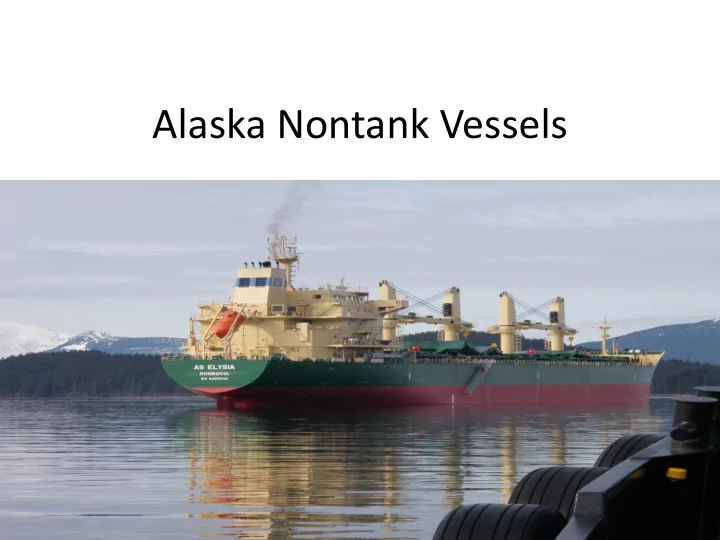

Alaska Nontank Vessels
A Nontank Vessel (NTV) is regulated if: • 1) It is > 400 gross registered tons (GRT)… – GRT is not the weight of the vessel, but is related to the internal space of the vessel. – Each 100 cubic feet of internal volume equals 1 GRT. – GRT is listed on the vessels Certificate of Registry issued by the vessels flag State. – Refer to 46 CFR 69 and 33 CFR 138.30. … AND • 2) … it is self-propelled. – A self-propelled vessel is capable of navigation.
Types of NTV’s include: (but not limited to) Cruise Ships
Passenger Ferries
Yachts
Cargo Ships
Fishing Vessels
Alaska State Waters • A NTV may not operate in State waters without State approval. • State approval consists of both an Alaska-approved oil discharge prevention and contingency plan and proof of financial responsibility. • State waters extend seaward 3 nautical miles from lower, low water, known as the baseline, established by NOAA. • Additional areas included as State waters are Cook Inlet & Prince William Sound (line of demarcation for Kennedy Entrance, and Hinchinbrook Entrance respectively).
Requirements for NTV’s • In 2000, Alaska legislature expanded the State’s “safety net” to include requirements for NTV’s to obtain Alaska-approved oil discharge prevention and contingency plans (plan) and proof of financial responsibility to operate in Alaska State waters. • An applicant that gains State approval of a plan is called a “plan holder”.
Implementation • Development of these requirements considered planning criteria that was: – Realistic, capable of being implemented with available technology; – Effective, providing real protection of the environment; – Economically feasible, capable of being implemented without unreasonable cost, and – Flexible, providing a wide variety of options and choices for vessel owners and operators to meet the requirements of the law.
NTV Contingency Plan • The plan is centered around the response planning standard (RPS), which identifies the amount of oil (fuel) by volume that the plan holder must be able to control, contain, and cleanup. • The RPS for NTV’s is 15% of the total capacity of fuel that can be held in the vessels fuel storage tanks.
Response Planning Standard • The Response Planning Standard (RPS) was established to identify the volume of fuel, specific to each NTV, for which a person must contain and control within 48 hours, and cleanup within the shortest possible time consistent with minimizing damage to the environment.
Contingency Plan Options A plan holder can demonstrate their ability to meet the RPS by: 1. Contracting with NTV primary response action contractors (PRACs) for containment and control, cleanup and incident management; or 2. Demonstrating “equivalent” resources for containment and control, cleanup and incident management; or 3. A combination of 1 & 2.
Streamlined Plan Option • Alaska developed the “Streamlined” plan process to meet Option 1. • The Streamlined option requires the plan holder to contract out all duties to NTV PRAC’s. • All plan holders to date have selected the streamlined plan option.
Equivalent Plan Option • The “equivalent” plan option provides the plan holder the ability to demonstrate they can meet the RPS without exclusively using NTV PRAC’s. • Currently all approved NTV plans are streamlined plans.
Response Planning Facilitator • The plan holder has the option of utilizing the services of a registered NTV response planning facilitator (RPF). • RPF services may include: • Acting as an intermediary between the plan holder and the NTV PRAC’s to facilitate contracts, or • Entering into a contract with the plan holder to meet the regulatory requirements.
NTV PRAC’s • There are 2 type of NTV PRACs: – The Incident Management Team (IMT), and – The Clean Up contractor (CC). • For a NTV PRAC to be listed in a plan, the PRAC must be registered with the state of Alaska. • For a NTV PRAC to be registered, they must demonstrate they can respond on behalf of a plan holder to meet the RPS.
Obtaining Plan Approval • The plan holder must complete an application and with required attachments, submit to the department for review and approval. • A determination will be made by the department within 5 days. • Approval for a NTV to operate in Alaska state waters requires the plan holder to also obtain proof of financial responsibility.
Proof of Financial Responsibility • Approved proof of financial responsibility is required to ensure that regulated plan holders have the financial resources to respond to an actual or potential oil spill. • A complete application must be submitted for approval at least 15 days prior to operation in State waters.
Alaska Contacts • Application forms can be found on the Alaska state website. • Contingency plan forms and contacts are located at: http://dec.alaska.gov/spar/ipp/marine-vessels • Financial responsibility forms and contacts are located at: http://dec.alaska.gov/spar/ipp/fr
Recommend
More recommend